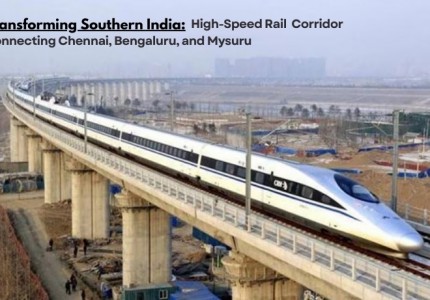Transforming Southern India: High-Speed Rail Corridor Connecting Chennai, Bengaluru, and Mysuru
.jpg)
A Game-Changer in Indian Railways
India’s railway network is on the brink of a revolutionary upgrade with the introduction of a new high-speed rail corridor that will link Chennai, Bengaluru, and Mysuru. This ambitious infrastructure project promises to redefine travel efficiency and connectivity across these major southern cities, marking a significant milestone in the country's transportation evolution.
Project Overview and Specifications
The proposed high-speed rail corridor will cover an impressive distance of approximately 463 kilometres. Designed to support trains with speeds reaching 350 km/h, the project aims for an operational speed of 320 km/h and an average cruising speed of 250 km/h. Such remarkable speeds will substantially reduce travel times, potentially cutting the journey between Chennai and Mysuru to just 90 minutes, significantly improving travel durations.
Strategic Station Placement
To ensure optimal accessibility and convenience for passengers, the corridor will include eleven strategically placed stations:
- Chennai: Serving as the starting point and a major transportation hub.
- Poonamallee: An important suburban area in Chennai.
- Chittoor: A key city in Andhra Pradesh that will benefit from enhanced connectivity.
- Kolar: Known for its agricultural and industrial significance.
- Kodahalli (near Hoskote): A critical junction in the Bengaluru metropolitan area.
- Whitefield: A major IT and commercial district in Bengaluru, ensuring easy access for technology professionals.
- Baiyappanahalli: A significant transit point in the eastern part of Bengaluru.
- Electronics City: A major IT and industrial hub, further integrating Bengaluru’s technology sector.
- Kengeri: A vital station providing connectivity to the western suburbs of Bengaluru.
- Mandya: An important city in Karnataka with strong agricultural and industrial sectors.
- Mysuru: The final destination, a city renowned for its cultural heritage and tourism appeal.
The inclusion of stations at major IT and industrial hubs such as Whitefield and Electronics City highlights the corridor’s role in supporting the region’s thriving technology sector and economic development.
Current Status and Development Phases
The high-speed rail project is currently in the early stages of development. The Ministry of Railways has tasked the National High-Speed Rail Corporation Limited (NHSRCL) with preparing comprehensive project reports. This phase will be crucial for finalizing the route alignment, and construction methods, and conducting essential environmental and social impact assessments.
Construction and Engineering Details
The construction of this high-speed rail corridor will involve a blend of elevated tracks, at-grade sections, and tunnel networks. A notable feature of the project is its 30-kilometer tunnel system, which will include segments in Chennai, Chittoor, Bengaluru Rural, and within the city of Bengaluru itself. This design aims to minimize disruption to existing infrastructure and preserve the region’s natural landscapes.
Land Acquisition and Compensation
Land acquisition is a critical aspect of the project, with approximately 1,162 hectares required. The government is dedicated to a fair and transparent acquisition process, offering compensation at market rates to affected landowners. This approach aims to facilitate a smoother transition and minimize resistance during the land acquisition phase.
Economic and Social Benefits
The high-speed rail corridor is expected to deliver extensive economic and social benefits, including:
- Economic Growth: Enhanced connectivity will likely stimulate economic activities in the regions connected by the corridor. Businesses will benefit from improved access to markets and resources, potentially leading to increased investments and job creation.
- Tourism Boost: By linking major cultural and tourist destinations, the corridor will make travel easier for tourists, boosting the tourism industry in cities like Mysuru and Chennai.
- Quality of Life: The reduced travel times and improved accessibility will enhance the quality of life for residents, making commuting more convenient and efficient.
A Milestone in India's Transportation Evolution
The development of the high-speed rail corridor connecting Chennai, Bengaluru, and Mysuru represents a groundbreaking advancement in India’s transportation infrastructure. By significantly shortening travel times and improving connectivity across southern India, this project is set to revolutionize regional mobility, drive economic growth, and enhance the overall quality of life for residents in these key urban centres. As the project progresses, it will be a testament to India’s commitment to modernizing its infrastructure and fostering a more interconnected future.
